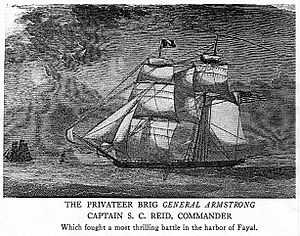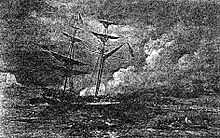General Armstrong
 | |
| Career (United States) | |
|---|---|
| Name: | General Armstrong |
| Namesake: | John Armstrong, Sr. |
| Homeport: | Baltimore, Maryland |
| Fate: | Scuttled on 27 September 1814 at Fayal. |
| General characteristics | |
| Type: | Brig |
| Tons burthen: | 246 tons |
| Complement: | 90 officers and men |
| Armament: | 8 × 9 long pounder 1 long 42-pounder (Long Tom) |
| Notes: | War of 1812 |
The General Armstrong was an American brig built for privateering during the Atlantic Ocean theater of the War of 1812. She was named for Brigadier General John Armstrong, Sr. who fought in the American Revolutionary War.
War of 1812
The General Armstrong had a crew of about 90 men, under the command of Captain Samuel Chester Reid, and was armed with seven guns, including a Long Tom.
Battle of Surinam River 11 March 1813 Under the captaincy of Guy R Champlin, the General Armstrong encountered a vessel that it presumed to be a British privateer Coquette[1]
In his log-book he wrote: "In this action we had six men killed and sixteen wounded, and all the halyards of the headsails shot away; the fore-mast and bowsprit one quarter cut through, and all the fore and main shrouds but one shot away; both mainstays and running rigging cut to pieces; a great number of shot through our sails, and several between wind and water, which caused our vessel to leak. There were also a number of shot in our hull."
The General Armstrong returned to the US and arrived in Charleston 4 April. [2] Other engagements 1812
29 Nov 1812 unsuccessful attack on Maxwell off coast of Brazil[3] Sir Sidney Smith, captured and ordered to port, foundered off Nantucket.[4][notes 1] Brig Union, from Guernsey for St Christopher's captured and sent to New York[5] Brig Lucy and Alida, with full cargo of dry goods, captured by General Armstrong and ordered to port, recaptured by British privateer Brenton of Liverpool, recaptured by Revenge from Norfolk.[6] 1813
Unnamed Schooner, captured by General Armstrong on her passage to France, and burnt.[7] Unnamed Brig, captured by General Armstrong on her passage to France, and burnt.[8] 1814
Sloop resoulution, from Jersey for Lisbon with linen and paper, captured by the General Armstrong on her passage from France, disposessed of her cargo and released. Brig Phoebe, from Forney for Maderia, laden with butter and potatoes, captured and scuttled.[9] General Armstrong arrived in New York. Lloyds list 26 April 1814 reported that the General Armstrong was seized and the crew taken prisoner when in put into Dunkirk[10]
25 June 1814, The General Armstrong, capt Champlin, captured the Portuguese ship Mercury, allowed to proceed as she was neutral.[11]
Brig, Duke of York, of Grenock, captured and burnt
Sloop George, laden with pork, captured off the coast of Ireland , and sunk.
Brig Swift, in ballast, captured, and made a cartel of[notes 2]
Brig Defiance, laden with whiskey, butter and bread, for Lisbon, captured and burnt
Brig Freindship, laden as above, captured and burnt
Brig Stag, laden with a full and very valuable cargo of dry goods, captured and divested of some articles and burnt, in sight of a British frigate, brig and schooner.
Ship Dorcas, out of Anguilla, captured by the boats of the General Armstrong, and sunk.
19 July 1814, Sloop Henrietta, bound to Chesapeake with stores, captured and sent to Egg Harbour
Three other very valuable prizes, captured, manned by prize crews and ordered into port.[12]
18 April 1814 the General Armstromg captured the Fanny, possibly the Fanny was one of the 3 unnamed prizes detailed in Niles' Register.
Of the prizes that were captured and ordered to port, about a third were recaptured. Battle damaged and short manned they were fairly easily re-captured. Niles' Register details the plight of one such captured vessel.
"Shifting Owners! The prize schooner to the General Armstrong (lately arrived at an Eastern Port) was formerly the Matilda, American privateer. She was captured on the Brazil coast, some months since, by the Lion, British privateer ship of 28 guns, after severe action, recaptured going into England bu the late U.S. Brig Argus, re-captured going into France by a British 74, and again re-captured by the American privateer Armstrong.
After a successful cruise, General Armstrong, capt. Guy Champlin arrived in home port late July 1814. Samuel Reid took over as captain and departed Sandy Hook on xx Aug 1814. On 19 April 1814, she captured the British armed merchantman Fanny, of eighteen guns and forty-five men, off the coast of Ireland. The engagement, which lasted about an hour, was described as a "severe" close range action. The entire battle was fought within "pistol shot range" and eventually the British struck their colors after losing several men either killed or wounded. The crew of the General Armstrong lost one killed and six wounded, the Fanny a like number. The British ship third rate Sceptre later recaptured Fanny.[1]
General Armstrong is most remembered for her involvement in the Battle of Fayal from 26 to 27 September 1814. In the engagement, the British brig-sloop Carnation and several boats armed with cannon and carrying sailors and marines, attempted to cut out the General Armstrong. General Armstrong repulsed the attacks but Captain Reid felt he had no chance of escaping the Azores so he ordered the scuttling of General Armstrong after fighting off the Carnation for a final time on 27 September. The Americans made it to shore where the Portuguese authorities protected them. Casualties amounted to two killed and seven wounded for the United States; the British lost 36 men killed and 93 wounded. Two of their boats were sunk and two others were captured.[2]

Legacy
Claims for damages arising out of the sinking of the General Armstrong lasted for over 70 years, and even became subject matter for The Senator, a popular play in the 1890s.
References
- ↑ Williams, Gomer (1897) History of the Liverpool privateers and letters of marque with an account of the Liverpool slave trade.
- ↑ http://bobrowen.com/nymas/warof1812paper/paperrevised2006.html
This article incorporates text from the public domain Dictionary of American Naval Fighting Ships.